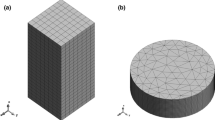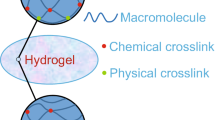Abstract
Tissue-equivalents (TEs), simple model tissues with tunable properties, have been used to explore many features of biological soft tissues. Absent in most formulations however, is the residual stress that arises due to interactions among components with different unloaded levels of stress, which has an important functional role in many biological tissues. To create a pre-stressed model system, co-gels were fabricated from a combination of hyaluronic acid (HA) and reconstituted Type-I collagen (Col). When placed in solutions of varying osmolarity, HA-Col co-gels swell as the HA imbibes water, which in turn stretches (and stresses) the collagen network. In this way, co-gels with residual stress (i.e., collagen fibers in tension and HA in compression) were fabricated. When the three gel types tested here were immersed in hypotonic solutions, pure HA gels swelled the most, followed by HA-Col co-gels; no swelling was observed in pure collagen gels. The greatest swelling rates and swelling ratios occurred in the lowest salt concentration solutions. Tension on the collagen component of HA-Col co-gels was calculated from a stress balance and increased nonlinearly as swelling increased. The swelling experiment results were in good agreement with the stress predicted by a fibril network + non-fibrillar interstitial matrix computational model.





Similar content being viewed by others
References
Albro, M. B., N. O. Chahine, M. Caligaris, V. I. Wei, K. W. Ng, C. T. Hung, and G. A. Ateshian. NIH Public Access. 129:503–510, 2010.
Alexander, A., and R. B. Donoff. The glycosaminoglycans of open wounds. J. Surg. Res. 29(5):422–429, 1980.
Alexander-Katz, A., and R. R. Netz. Dynamics and instabilities of collapsed polymers in shear flow. Macromolecules 41:3363–3374, 2008.
Anandagoda, N., D. G. Ezra, U. Cheema, M. Bailly, and R. A. Brown. Hyaluronan hydration generates three-dimensional meso-scale structure in engineered collagen tissues. J. R. Soc. Interface 9:2680–2687, 2012.
Armon, S., E. Efrati, R. Kupferman, and E. Sharon. Geometry and mechanics in the opening of chiral seed pods. Science 333:1726–1729, 2011.
Ateshian, G. A., S. Maas, and J. A. Weiss. Multiphasic finite element framework for modeling hydrated mixtures with multiple neutral and charged solutes. J. Biomech. Eng. 135:111001, 2013.
Barocas, V. H., and R. T. Tranquillo. An anisotropic biphasic theory of tissue-equivalent mechanics: the interplay among cell traction, fibrillar network deformation, fibril alignment, and cell contact guidance. J. Biomech. Eng. 119:137, 1997.
Bell, E., B. Ivarsson, and C. Merrill. Production of a tissue-like structure by contraction of collagen lattices by human fibroblasts of different proliferative potential in vitro. Proc. Natl. Acad. Sci. USA 76:1274–1278, 1979.
Choh, S. Y., D. Cross, and C. Wang. Facile synthesis and characterization of disulfide-cross-linked hyaluronic acid hydrogels for protein delivery and cell encapsulation. Biomacromolecules 12:1126–1136, 2011.
Donnan, F. G. The theory of membrane equilibria. Chem. Rev. 1:73–90, 1924.
Frey, H., N. Schroeder, T. Manon-Jensen, R. V. Iozzo, and L. Schaefer. Biological interplay between proteoglycans and their innate immune receptors in inflammation. FEBS J. 280:2165–2179, 2013.
Fyhrie, D. P., and J. R. Barone. Polymer dynamics as a mechanistic model for the flow-independent viscoelasticity of cartilage. J. Biomech. Eng. 125:578–584, 2003.
Greco, R. M., J. A. Iocono, and H. P. Ehrlich. Hyaluronic acid stimulates human fibroblast proliferation within a collagen matrix. J. Cell. Physiol. 177:465–473, 1998.
Han, E., S. S. Chen, S. M. Klisch, and R. L. Sah. Contribution of proteoglycan osmotic swelling pressure to the compressive properties of articular cartilage. Biophys. J. 101:916–924, 2011.
Hargittai, I., and M. Hargittai. Molecular structure of hyaluronan: an introduction. Struct. Chem. 19:697–717, 2008.
Jhun, C.-S., M. C. Evans, V. H. Barocas, and R. T. Tranquillo. Planar biaxial mechanical behavior of bioartificial tissues possessing prescribed fiber alignment. J. Biomech. Eng. 131:081006, 2009.
Kreger, S. T., and S. L. Voytik-Harbin. Hyaluronan concentration within a 3D collagen matrix modulates matrix viscoelasticity, but not fibroblast response. Matrix Biol. 28:336–346, 2009.
Lai, V. K., C. R. Frey, A. M. Kerandi, S. P. Lake, R. T. Tranquillo, and V. H. Barocas. Microstructural and mechanical differences between digested collagen-fibrin co-gels and pure collagen and fibrin gels. Acta Biomater. 8:4031–4042, 2012.
Lai, V. K., S. P. Lake, C. R. Frey, R. T. Tranquillo, and V. H. Barocas. Mechanical behavior of collagen-fibrin co-gels reflects transition from series to parallel interactions with increasing collagen content. J. Biomech. Eng. 134:011004, 2012.
Lake, S. P., and V. H. Barocas. Mechanical and structural contribution of non-fibrillar matrix in uniaxial tension: a collagen-agarose co-gel model. Ann. Biomed. Eng. 39:1891–1903, 2011.
Lake, S. P., M. F. Hadi, V. K. Lai, and V. H. Barocas. Mechanics of a fiber network within a non-fibrillar matrix: model and comparison with collagen-agarose co-gels. Ann. Biomed. Eng. 40:2111–2121, 2012.
Lake, S. P., E. S. Hald, and V. H. Barocas. Collagen-agarose co-gels as a model for collagen-matrix interaction in soft tissues subjected to indentation. J. Biomed. Mater. Res. A 99:507–515, 2011.
Lanir, Y. Osmotic swelling and residual stress in cardiovascular tissues. J. Biomech. 45:780–789, 2012.
Laurent, T. C. The Chemistry, Biology and Medical Applications of Hyaluronan and Its Derivatives. London: Portland Press Limited, p. 368, 1998.
Luo, Y., K. R. Kirker, and G. D. Prestwich. Cross-linked hyaluronic acid hydrogel films: new biomaterials for drug delivery. J. Control. Release 69:169–184, 2000.
Marquez, J. P., G. M. Genin, K. M. Pryse, and E. L. Elson. Cellular and matrix contributions to tissue construct stiffness increase with cellular concentration. Ann. Biomed. Eng. 34:1475–1482, 2006.
Michalek, A. J., M. G. Gardner-Morse, and J. C. Iatridis. Large residual strains are present in the intervertebral disc annulus fibrosus in the unloaded state. J. Biomech. 45:1227–1231, 2012.
Moon, A. G., and R. T. Tranquillo. Fibroblast-populated collagen microsphere assay of cell traction force. 1. Continuum model. Aiche J. 39:163–177, 1993.
Mow, V. C., M. H. Holmes, and W. M. Lai. Fluid transport and mechanical properties of articular cartilage: a review. J. Biomech. 17:377–394, 1984.
Nardinocchi, P., and M. Pezzulla. Curled actuated shapes of ionic polymer metal composites strips. J. Appl. Phys. 113:224906, 2013.
Nelson, D. Experimental methods for determining residual stresses and strains in various biological structures. Exp. Mech. 54:695–708, 2014.
Pan, Y., and Z. Zhong. A nonlinear constitutive model of unidirectional natural fiber reinforced composites considering moisture absorption. J. Mech. Phys. Solids 69:132–142, 2014.
Park, S.-N., H. J. Lee, K. H. Lee, and H. Suh. Biological characterization of EDC-crosslinked collagen-hyaluronic acid matrix in dermal tissue restoration. Biomaterials 24:1631–1641, 2003.
Roeder, B. A., K. Kokini, J. E. Sturgis, J. P. Robinson, and S. L. Voytik-Harbin. Tensile mechanical properties of three-dimensional type I collagen extracellular matrices with varied microstructure. J. Biomech. Eng. 124:214, 2002.
Ruberti, J. W., and J. B. Sokoloff. Theory of the short time mechanical relaxation in articular cartilage. J. Biomech. Eng. 133:104504, 2011.
Sander, E., A. T. Stylianopoulos, T. Tranquillo, and V. H. Barocas. Image-based multiscale modeling predicts tissue-level and network-level fiber reorganization in stretched cell-compacted collagen gels. Proc. Natl. Acad. Sci. USA 106:17675–17680, 2009.
Segura, T., B. C. Anderson, P. H. Chung, R. E. Webber, K. R. Shull, and L. D. Shea. Crosslinked hyaluronic acid hydrogels: a strategy to functionalize and pattern. Biomaterials 26:359–371, 2005.
Taber, L. A., and J. D. Humphrey. Stress-modulated growth, residual stress, and vascular heterogeneity. J. Biomech. Eng. 123:528–535, 2001.
Walters, B. D., and J. P. Stegemann. Strategies for directing the structure and function of three-dimensional collagen biomaterials across length scales. Acta Biomater. 10:1488–1501, 2014.
Weiss, J. A. Computational modeling of ligament mechanics. Crit. Rev. Biomed. Eng. 29:303–371, 2001.
Zheng Shu, X., Y. Liu, F. S. Palumbo, Y. Luo, and G. D. Prestwich. In situ crosslinkable hyaluronan hydrogels for tissue engineering. Biomaterials 25:1339–1348, 2004.
Acknowledgments
This work was supported by the National Institute of Health (RO1 EB005813), and by a resources grant from the Minnesota Supercomputing Institute. There are no conflicts of interest.
Author information
Authors and Affiliations
Corresponding author
Additional information
Associate Editor Kent Leach oversaw the review of this article.
Rights and permissions
About this article
Cite this article
Lai, V.K., Nedrelow, D.S., Lake, S.P. et al. Swelling of Collagen-Hyaluronic Acid Co-Gels: An In Vitro Residual Stress Model. Ann Biomed Eng 44, 2984–2993 (2016). https://doi.org/10.1007/s10439-016-1636-0
Received:
Accepted:
Published:
Issue Date:
DOI: https://doi.org/10.1007/s10439-016-1636-0




